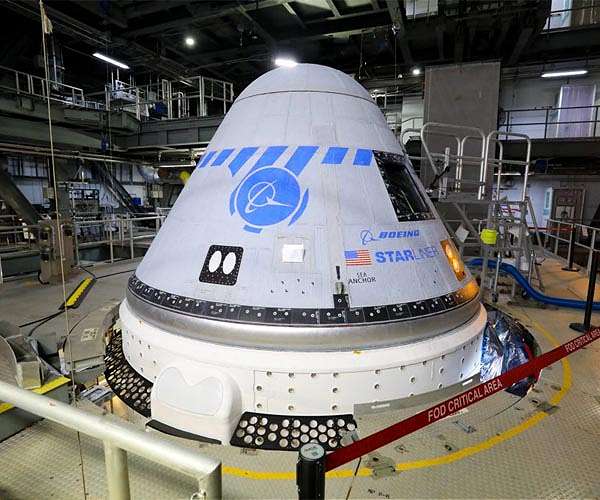
NASA sets mid-May launch for Boeing Starliner spacecraft’s initial trip to ISS (Image Credit: Space Daily)
Boeing’s Starliner spacecraft may finally get off the ground for its second flight following an issue with the craft’s propulsion system.
The capsule, designed to ferry astronauts to and from the International Space Station, is set to launch on its second uncrewed test flight on May 19, company officials confirmed during a teleconference on Tuesday.
The mission, Orbital Flight Test-2, is part of NASA’s Commercial Crew Program, in this case with the agency contracting Boeing and SpaceX to transport astronauts to the ISS.
Liftoff is scheduled for 6:54 p.m. EDT from Space Launch Complex-41 at Cape Canaveral Space Force Station in Florida.
The test was originally slated to take place last summer, but was canceled after engineers discovered 13 valves in the craft’s propulsion system that were stuck in the closed position.
Following extensive work and troubleshooting both at the launch pad and in the factory, Boeing determined that the valves were sealed shut due to corrosion from moisture interacting with an oxidizer, company officials said Tuesday during a phone briefing with reporters.
Once Boeing got the vehicle back to its factory and took the valves apart, engineers were able to determine that a mixture of nitrogen tetroxide, or NTO, which is used as an oxidizer in rocket fuel, and ambient moisture interacted with the aluminum covering on the valves.
“In order to mitigate corrosion and reduce moisture, going forward we will load the NTO later [in the fueling process] and cycle the valves every few days,” Michelle Parker, vice president and deputy general manager for Boeing Space and Launch, said during the briefing.
“We didn’t find any other issues [with Starliner] when we were investigating the valve issue. Nothing was changed with the valves themselves, except for sealing a potential ambient moisture path in an electrical connector,” Parker said.
Based on data from the May 19 test flight, a crewed test flight could happen by the end of the year, Mark Nappi, vice president and manager of the Boeing commercial crew program, said during the briefing.
That test would include a trio of astronauts — Butch Wilmore, Micke Fincke and a yet to be named mission specialist.
Once Starliner has proven it can safely launch, dock itself and land, the spacecraft could begin regular crewed flights to the ISS, joining SpaceX in NASA’s commercial crew program.
Both SpaceX’s Crew Dragon and Boeing’s Starliner are fully autonomous and designed to dock themselves to the space station.
Since there will not be a crew on board this flight, the astronauts on the space station will have the capability to remote pilot the craft if necessary as its docks to the ISS. If necessary, however, the spacecraft can also be controlled by folks on the ground.
According to NASA’s ISS program manager, Joel Montalbano, the agency’s international partners — including Russia — have given Starliner the go ahead to dock with the orbital outpost, clearing the way for one of the last steps remaining to certify Starliner for human use.
Related Links
Rocket Science News at Space-Travel.Com
|
|
Tweet |
|
|
|
We need your help. The SpaceDaily news network continues to grow but revenues have never been harder to maintain. With the rise of Ad Blockers, and Facebook – our traditional revenue sources via quality network advertising continues to decline. And unlike so many other news sites, we don’t have a paywall – with those annoying usernames and passwords. Our news coverage takes time and effort to publish 365 days a year. If you find our news sites informative and useful then please consider becoming a regular supporter or for now make a one off contribution. |
||
|
SpaceDaily Monthly Supporter $5+ Billed Monthly |
SpaceDaily Contributor $5 Billed Once credit card or paypal |
|
Successful test launch a giant leap for rocketry team
Sydney, Australia (SPX) May 03, 2022
Students of the University of Sydney’s rocketry society, the USYD Rocketry Team, have their eyes firmly set on gold after successfully launching their 2022 competition rocket in New South Wales’s far west.
After a two-year pandemic hiatus, the team will fly to the US in June to compete at Spaceport America Cup, an international student rocketry competition held annually in New Mexico.
Last week, the student team’s rocket, Bluewren, soared to a target height of 30,000 feet – roughly 9 kilomet … read more








